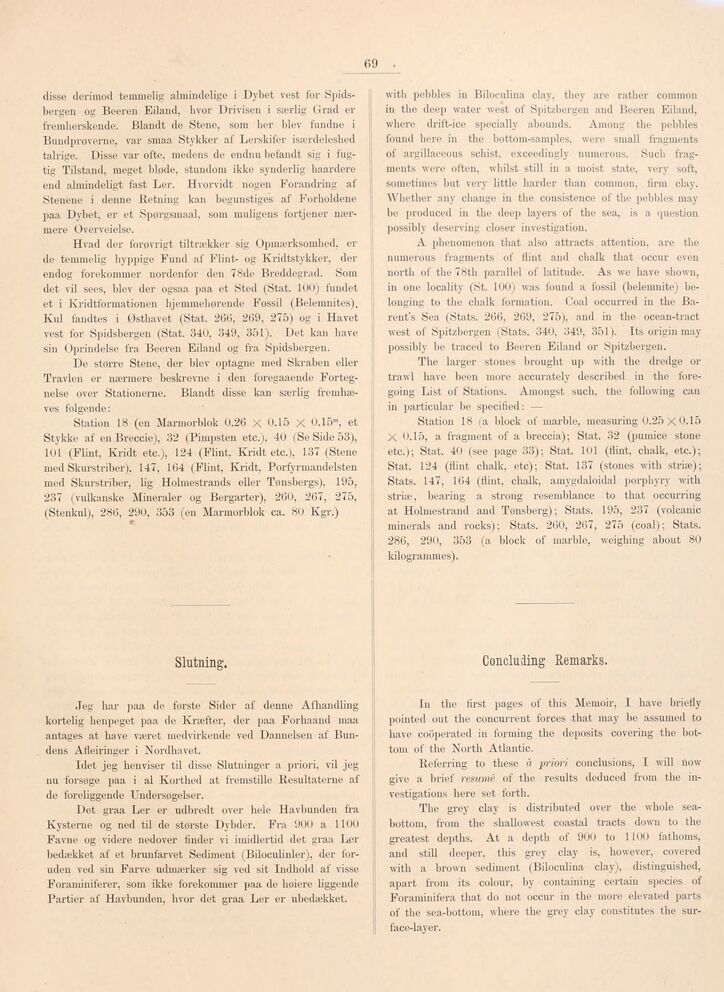
Full resolution (JPEG) - On this page / på denna sida - Sidor ...

<< prev. page << föreg. sida << >> nästa sida >> next page >>
Below is the raw OCR text
from the above scanned image.
Do you see an error? Proofread the page now!
Här nedan syns maskintolkade texten från faksimilbilden ovan.
Ser du något fel? Korrekturläs sidan nu!
This page has never been proofread. / Denna sida har aldrig korrekturlästs.
69
disse derimod temmelig almindelige i Dybet vest for
Spidsbergen og Beeren Eiland, hvor Drivisen i særlig Grad er
fremherskende. Blandt de Stene, som her blev fundne i
Bundprøverne, var smaa Stykker af Lerskifer isærdeleshed
talrige. Disse var ofte, medens de endnu befandt sig i
fugtig Tilstand, meget bløde, stundom ikke synderlig haardere
end almindeligt fast Ler. Hvorvidt nogen Forandring af
Stenene i denne Retning kan begunstiges af Forholdene
paa Dybet, er et Spørgsmaal, som muligens fortjener
nærmere Overveielse.
Hvad der forøvrigt tiltrækker sig Opmærksomhed,
eide temmelig hyppige Fund af Flint- og Kridtstykker, der
endog forekommer nordenfor den 78de Breddegrad. Som
det vil sees, blev der ogsaa paa et Sted (Ståt. 100) fundet
et i Kridtformationen hjemmehørende Fossil (Belemnites).
Kul fandtes i Østliavet (Ståt. 266, 269, 275) og i Havet
vest for Spidsbergen (Ståt. 340, 349, 351). Det kan have
sin Oprindelse fra Beeren Eiland og fra Spidsbergen.
De større Stene, der blev optagne med Skraben eller
Travlen er nærmere beskrevne i den foregaaende
Fortegnelse over Stationerne. Blandt disse kan særlig
fremhæves følgende:
Station 18 (en Marmorblok 0.26 X 0.15 X 0.15m, et
Stykke af en Breccie), 32 (Pimpsten etc.), 40 (Se Side 53),
101 (Flint, Kridt etc.), 124 (Flint, Kridt etc.), 137 (Stene
med Skurstriber), 147, 164 (Flint, Kridt, Porfyrmandelsten
med Skurstriber, lig Holmestrands eller Tønsbergs), 195,
237 (vulkanske Mineraler og Bergarter), 260, 267, 275,
(Stenkul), 286, 290, 353 (en Marmorblok ca. 80 Kgr.)
with pebbles in Biloculina clay, they are rather common
in the deep water west of Spitzbergen and Beeren Eilancl,
where clrift-ice specially abounds. Among the pebbles
found here in the bottom-samples, were small fragments
of argillaceous schist, exceedingly numerous. Such
fragments were often, whilst still in a moist state, very soft,
sometimes but very little harder than common, firm clay.
Whether any change in the consistence of the pebbles may
be produced in the deep layers of the sea, is a question
possibly deserving closer investigation.
A phenomenon that also attracts attention, are the
numerous fragments of flint and chalk that occur even
north of the 78th parallel of latitude. As we have shown,
in one locality (St. 100) was found a fossil (belemnite)
belonging to the chalk formation. Goal occurred in the
Barents Sea (Stats. 266, 269, 275), and in the ocean-tract
west of Spitzbergen (Stats. 340, 349, 351). Its origin may
possibly be traced to Beeren Eiland or Spitzbergen.
The larger stones brought up with the dredge or
trawl have been more accurately described in the
foregoing List of Stations. Amongst such, the following can
in particular be specified: —
Station 18 (a block of marble, measuring 0.25x0.15
X 0.15, a fragment of a breccia); Ståt. 32 (pumice stone
etc.); Ståt. 40 (see page 33); Ståt. 101 (flint, chalk, etc.);
Ståt. 124 (flint chalk, etc); Ståt. 137 (stones with striæ);
Stats. 147, 164 (flint, chalk, amygclaloidal porphyry with
striæ, bearing a strong resemblance to that occurring
at Holmestrand and Tønsberg); Stats. 195, 237 (volcanic
minerals and rocks); Stats. 260, 267, 275 (coal); Stats.
286, 290, 353 (a block of marble, weighing about 80
kilogrammes).
Slutning.
Jeg har paa de første Sider af denne Afhandling
kortelig henpeget paa cle Kræfter, der paa Forhaand maa
antages at have været medvirkende vecl Dannelsen af
Bundens Afleiringer i Nordhavet.
Iclet jeg henviser til clisse Slutninger a priori, vil
jeg-nu forsøge paa i al Korthed at fremstille Resultaterne af
de foreliggende Undersøgelser.
Det graa Ler er udbredt over hele Havbunden fra
Kysterne og necl til de største Dybder. Fra 900 a 1100
Favne og videre nedover finder vi imidlertid clet graa Ler
bedækket af et brunfarvet Sediment (Biloculinler), eier
foruden vecl sin Farve udmærker sig ved sit Indhold af visse
Foraminiferer, som ikke forekommer paa cle høiere liggende
Partier af Havbunden, hvor clet graa Ler er ubedækket.
Concluding Remarks.
In the first pages of this Memoir, I have briefly
pointed out the concurrent forces that may be assumed to
have cooperated in forming the deposits covering the
bottom of the North Atlantic.
Referring to these å priori conclusions, I will now
give a brief resumé of the results deduced from the
investigations here set forth.
The grey clay is distributed over the whole
sea-bottom, from the shallowest coastal tracts clown to the
greatest depths. At a depth of 900 to 1100 fathoms,
and still deeper, this grey clay is, however, covered
with a brown sediment (Biloculina clay), distinguished,
apart from its colour, by containing certain species of
Foraminifera that do not occur in the more elevated parts
of the sea-bottom, where the grey clay constitutes the
surface-layer.
<< prev. page << föreg. sida << >> nästa sida >> next page >>